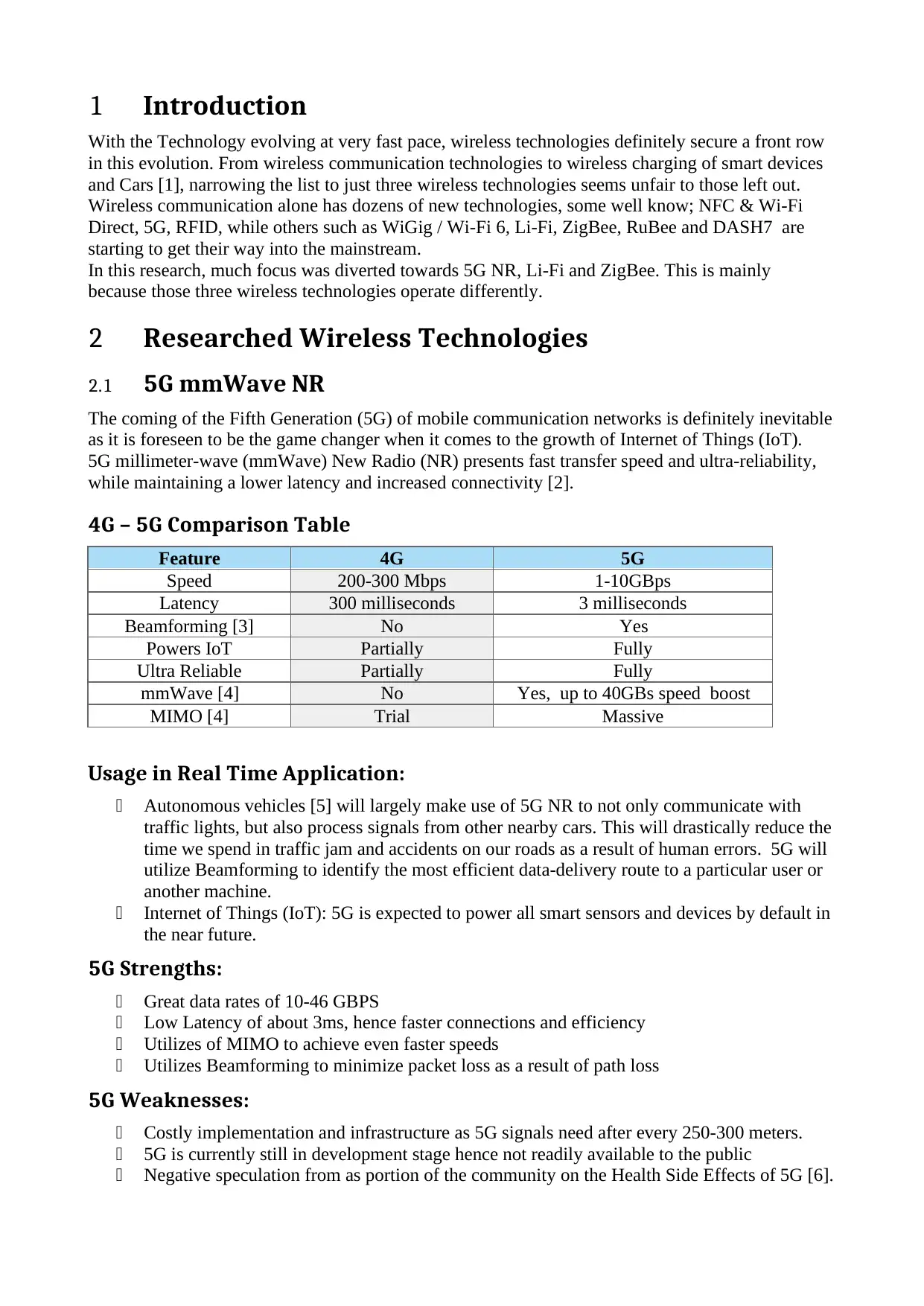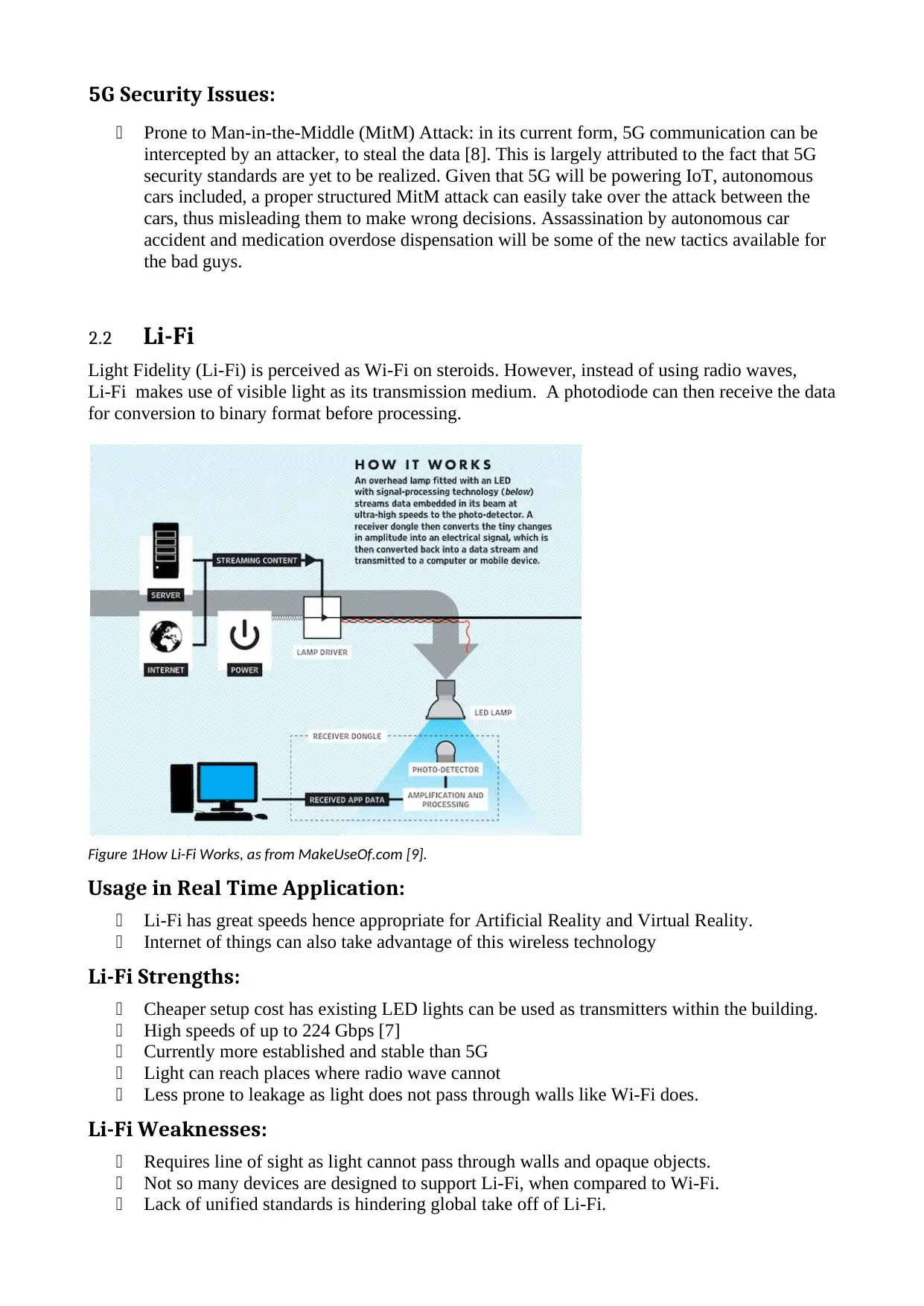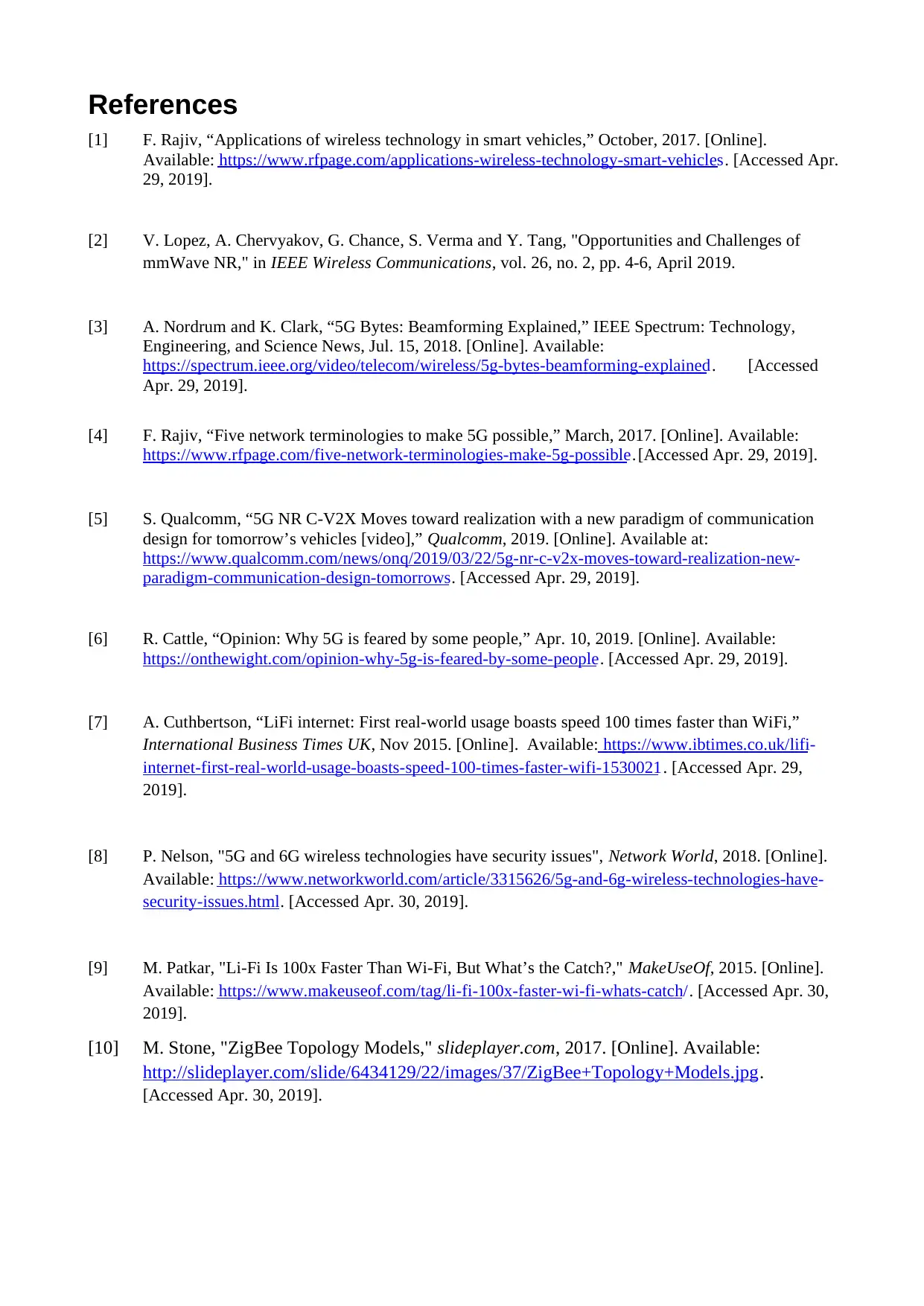Comparative Analysis of 5G NR, Li-Fi, and ZigBee Wireless Technologies
VerifiedAdded on 2022/12/21
|6
|1669
|80
Report
AI Summary
This report provides a comprehensive overview and comparative analysis of three prominent wireless technologies: 5G mmWave NR, Li-Fi, and ZigBee. The report begins by introducing the rapid evolution of wireless technologies and narrows its focus to these three, highlighting their differing operational characteristics. It delves into the features, applications, strengths, weaknesses, and security issues of each technology. 5G NR is examined for its high data rates, low latency, beamforming capabilities, and potential in IoT and autonomous vehicles, while also addressing its high implementation costs and health concerns. Li-Fi is explored for its high speeds and cost-effectiveness, and its suitability for AR/VR and IoT, while acknowledging its limitations in terms of line of sight and device compatibility. ZigBee is discussed for its low power consumption, suitability for machine-to-machine communication, and security vulnerabilities. The report concludes by comparing the three technologies, highlighting Li-Fi's superior data rate and cost-effectiveness, while acknowledging 5G's expected dominance in the IoT space.

Three Most Recent Wireless
Technologies
Name:
Student ID:
Course:
Code
Technologies
Name:
Student ID:
Course:
Code
Paraphrase This Document
Need a fresh take? Get an instant paraphrase of this document with our AI Paraphraser

1 Introduction
With the Technology evolving at very fast pace, wireless technologies definitely secure a front row
in this evolution. From wireless communication technologies to wireless charging of smart devices
and Cars [1], narrowing the list to just three wireless technologies seems unfair to those left out.
Wireless communication alone has dozens of new technologies, some well know; NFC & Wi-Fi
Direct, 5G, RFID, while others such as WiGig / Wi-Fi 6, Li-Fi, ZigBee, RuBee and DASH7 are
starting to get their way into the mainstream.
In this research, much focus was diverted towards 5G NR, Li-Fi and ZigBee. This is mainly
because those three wireless technologies operate differently.
2 Researched Wireless Technologies
2.1 5G mmWave NR
The coming of the Fifth Generation (5G) of mobile communication networks is definitely inevitable
as it is foreseen to be the game changer when it comes to the growth of Internet of Things (IoT).
5G millimeter-wave (mmWave) New Radio (NR) presents fast transfer speed and ultra-reliability,
while maintaining a lower latency and increased connectivity [2].
4G – 5G Comparison Table
Feature 4G 5G
Speed 200-300 Mbps 1-10GBps
Latency 300 milliseconds 3 milliseconds
Beamforming [3] No Yes
Powers IoT Partially Fully
Ultra Reliable Partially Fully
mmWave [4] No Yes, up to 40GBs speed boost
MIMO [4] Trial Massive
Usage in Real Time Application:
Autonomous vehicles [5] will largely make use of 5G NR to not only communicate with
traffic lights, but also process signals from other nearby cars. This will drastically reduce the
time we spend in traffic jam and accidents on our roads as a result of human errors. 5G will
utilize Beamforming to identify the most efficient data-delivery route to a particular user or
another machine.
Internet of Things (IoT): 5G is expected to power all smart sensors and devices by default in
the near future.
5G Strengths:
Great data rates of 10-46 GBPS
Low Latency of about 3ms, hence faster connections and efficiency
Utilizes of MIMO to achieve even faster speeds
Utilizes Beamforming to minimize packet loss as a result of path loss
5G Weaknesses:
Costly implementation and infrastructure as 5G signals need after every 250-300 meters.
5G is currently still in development stage hence not readily available to the public
Negative speculation from as portion of the community on the Health Side Effects of 5G [6].
With the Technology evolving at very fast pace, wireless technologies definitely secure a front row
in this evolution. From wireless communication technologies to wireless charging of smart devices
and Cars [1], narrowing the list to just three wireless technologies seems unfair to those left out.
Wireless communication alone has dozens of new technologies, some well know; NFC & Wi-Fi
Direct, 5G, RFID, while others such as WiGig / Wi-Fi 6, Li-Fi, ZigBee, RuBee and DASH7 are
starting to get their way into the mainstream.
In this research, much focus was diverted towards 5G NR, Li-Fi and ZigBee. This is mainly
because those three wireless technologies operate differently.
2 Researched Wireless Technologies
2.1 5G mmWave NR
The coming of the Fifth Generation (5G) of mobile communication networks is definitely inevitable
as it is foreseen to be the game changer when it comes to the growth of Internet of Things (IoT).
5G millimeter-wave (mmWave) New Radio (NR) presents fast transfer speed and ultra-reliability,
while maintaining a lower latency and increased connectivity [2].
4G – 5G Comparison Table
Feature 4G 5G
Speed 200-300 Mbps 1-10GBps
Latency 300 milliseconds 3 milliseconds
Beamforming [3] No Yes
Powers IoT Partially Fully
Ultra Reliable Partially Fully
mmWave [4] No Yes, up to 40GBs speed boost
MIMO [4] Trial Massive
Usage in Real Time Application:
Autonomous vehicles [5] will largely make use of 5G NR to not only communicate with
traffic lights, but also process signals from other nearby cars. This will drastically reduce the
time we spend in traffic jam and accidents on our roads as a result of human errors. 5G will
utilize Beamforming to identify the most efficient data-delivery route to a particular user or
another machine.
Internet of Things (IoT): 5G is expected to power all smart sensors and devices by default in
the near future.
5G Strengths:
Great data rates of 10-46 GBPS
Low Latency of about 3ms, hence faster connections and efficiency
Utilizes of MIMO to achieve even faster speeds
Utilizes Beamforming to minimize packet loss as a result of path loss
5G Weaknesses:
Costly implementation and infrastructure as 5G signals need after every 250-300 meters.
5G is currently still in development stage hence not readily available to the public
Negative speculation from as portion of the community on the Health Side Effects of 5G [6].

5G Security Issues:
Prone to Man-in-the-Middle (MitM) Attack: in its current form, 5G communication can be
intercepted by an attacker, to steal the data [8]. This is largely attributed to the fact that 5G
security standards are yet to be realized. Given that 5G will be powering IoT, autonomous
cars included, a proper structured MitM attack can easily take over the attack between the
cars, thus misleading them to make wrong decisions. Assassination by autonomous car
accident and medication overdose dispensation will be some of the new tactics available for
the bad guys.
2.2 Li-Fi
Light Fidelity (Li-Fi) is perceived as Wi-Fi on steroids. However, instead of using radio waves,
Li-Fi makes use of visible light as its transmission medium. A photodiode can then receive the data
for conversion to binary format before processing.
Figure 1How Li-Fi Works, as from MakeUseOf.com [9].
Usage in Real Time Application:
Li-Fi has great speeds hence appropriate for Artificial Reality and Virtual Reality.
Internet of things can also take advantage of this wireless technology
Li-Fi Strengths:
Cheaper setup cost has existing LED lights can be used as transmitters within the building.
High speeds of up to 224 Gbps [7]
Currently more established and stable than 5G
Light can reach places where radio wave cannot
Less prone to leakage as light does not pass through walls like Wi-Fi does.
Li-Fi Weaknesses:
Requires line of sight as light cannot pass through walls and opaque objects.
Not so many devices are designed to support Li-Fi, when compared to Wi-Fi.
Lack of unified standards is hindering global take off of Li-Fi.
Prone to Man-in-the-Middle (MitM) Attack: in its current form, 5G communication can be
intercepted by an attacker, to steal the data [8]. This is largely attributed to the fact that 5G
security standards are yet to be realized. Given that 5G will be powering IoT, autonomous
cars included, a proper structured MitM attack can easily take over the attack between the
cars, thus misleading them to make wrong decisions. Assassination by autonomous car
accident and medication overdose dispensation will be some of the new tactics available for
the bad guys.
2.2 Li-Fi
Light Fidelity (Li-Fi) is perceived as Wi-Fi on steroids. However, instead of using radio waves,
Li-Fi makes use of visible light as its transmission medium. A photodiode can then receive the data
for conversion to binary format before processing.
Figure 1How Li-Fi Works, as from MakeUseOf.com [9].
Usage in Real Time Application:
Li-Fi has great speeds hence appropriate for Artificial Reality and Virtual Reality.
Internet of things can also take advantage of this wireless technology
Li-Fi Strengths:
Cheaper setup cost has existing LED lights can be used as transmitters within the building.
High speeds of up to 224 Gbps [7]
Currently more established and stable than 5G
Light can reach places where radio wave cannot
Less prone to leakage as light does not pass through walls like Wi-Fi does.
Li-Fi Weaknesses:
Requires line of sight as light cannot pass through walls and opaque objects.
Not so many devices are designed to support Li-Fi, when compared to Wi-Fi.
Lack of unified standards is hindering global take off of Li-Fi.
⊘ This is a preview!⊘
Do you want full access?
Subscribe today to unlock all pages.

Trusted by 1+ million students worldwide

Li-Fi Security Issues:
Interference from Other led lights and possible Denial of Service Attack.
While the wireless technology presents high speeds, there is currently no way of preventing
other led lights from being processed by the receiver. This means literally all incoming Led
lights are processed. This can be used as a form of attack to exhaust the server resources by
sending endless packets to the server by an attacker.
2.3 ZigBee
This wireless technology operates at low power mode.
ZigBee is designed with machine-to-machine communication in mind and can be categorized along
with NFC and Bluetooth technologies. ZigBee take the place of the infrared technology.
Figure 2 ZigBee Topology: by ZigBee Alliance [10]
Usage in Real Time Application:
Sensor technology in industrial applications, as ZigBee operates at low power
Securely power IoT devices.
ZigBee Strengths:
Secure data transmission
Highly scalable and efficient data transfer.
Easy to setup and Energy Efficient
Supports load balancing
Widely adopted when compared to 5G
ZigBee Weaknesses:
Low power mode hence limited physical coverage
Yet to be standardized, hence compatibility issues between ZigBee devices is a common
thing.
ZigBee Security Issues:
Poor implementation by most manufacturers in the race to provide ZigBee enabled products
to end users. This has drastically resulted into many ZigBee enabled devices being
vulnerable.
Secret Key easily retrieved through network sniffing.
Interference from Other led lights and possible Denial of Service Attack.
While the wireless technology presents high speeds, there is currently no way of preventing
other led lights from being processed by the receiver. This means literally all incoming Led
lights are processed. This can be used as a form of attack to exhaust the server resources by
sending endless packets to the server by an attacker.
2.3 ZigBee
This wireless technology operates at low power mode.
ZigBee is designed with machine-to-machine communication in mind and can be categorized along
with NFC and Bluetooth technologies. ZigBee take the place of the infrared technology.
Figure 2 ZigBee Topology: by ZigBee Alliance [10]
Usage in Real Time Application:
Sensor technology in industrial applications, as ZigBee operates at low power
Securely power IoT devices.
ZigBee Strengths:
Secure data transmission
Highly scalable and efficient data transfer.
Easy to setup and Energy Efficient
Supports load balancing
Widely adopted when compared to 5G
ZigBee Weaknesses:
Low power mode hence limited physical coverage
Yet to be standardized, hence compatibility issues between ZigBee devices is a common
thing.
ZigBee Security Issues:
Poor implementation by most manufacturers in the race to provide ZigBee enabled products
to end users. This has drastically resulted into many ZigBee enabled devices being
vulnerable.
Secret Key easily retrieved through network sniffing.
Paraphrase This Document
Need a fresh take? Get an instant paraphrase of this document with our AI Paraphraser

3 Why Li-Fi Stands Out
In my opinion, Li-Fi would really stand out because:
Its Data rate (speed) is way higher that what ZigBee and 5G will be offering.
Again the cost of setting up and maintaining Li-Fi is relatively lower than that of 5G.
Li-Fi has negligible Side effects on health since visible light is used. 5G on the other hand
makes use of millimeter-waves, which have negative side effects on health, and literally
interfere with proper cell functionality the closer you get to the transmitter.
Both 5G and Li-Fi will require new devices as existing devices don’t have the capability to
handles those new technologies. Both 5G and Li-Fi are limited in the way they can be used.
5G is limited by distance while Li-Fi by walls and obstacles. Given that the data rate of Li-
Fi is outweighs that of 5G, then Li-Fi deserves more focus. Unfortunately, 5G has been
declared as the Future of IoT hence will definitely take the day.
In my opinion, Li-Fi would really stand out because:
Its Data rate (speed) is way higher that what ZigBee and 5G will be offering.
Again the cost of setting up and maintaining Li-Fi is relatively lower than that of 5G.
Li-Fi has negligible Side effects on health since visible light is used. 5G on the other hand
makes use of millimeter-waves, which have negative side effects on health, and literally
interfere with proper cell functionality the closer you get to the transmitter.
Both 5G and Li-Fi will require new devices as existing devices don’t have the capability to
handles those new technologies. Both 5G and Li-Fi are limited in the way they can be used.
5G is limited by distance while Li-Fi by walls and obstacles. Given that the data rate of Li-
Fi is outweighs that of 5G, then Li-Fi deserves more focus. Unfortunately, 5G has been
declared as the Future of IoT hence will definitely take the day.

References
[1] F. Rajiv, “Applications of wireless technology in smart vehicles,” October, 2017. [Online].
Available: https://www.rfpage.com/applications-wireless-technology-smart-vehicles. [Accessed Apr.
29, 2019].
[2] V. Lopez, A. Chervyakov, G. Chance, S. Verma and Y. Tang, "Opportunities and Challenges of
mmWave NR," in IEEE Wireless Communications, vol. 26, no. 2, pp. 4-6, April 2019.
[3] A. Nordrum and K. Clark, “5G Bytes: Beamforming Explained,” IEEE Spectrum: Technology,
Engineering, and Science News, Jul. 15, 2018. [Online]. Available:
https://spectrum.ieee.org/video/telecom/wireless/5g-bytes-beamforming-explained. [Accessed
Apr. 29, 2019].
[4] F. Rajiv, “Five network terminologies to make 5G possible,” March, 2017. [Online]. Available:
https://www.rfpage.com/five-network-terminologies-make-5g-possible.[Accessed Apr. 29, 2019].
[5] S. Qualcomm, “5G NR C-V2X Moves toward realization with a new paradigm of communication
design for tomorrow’s vehicles [video],” Qualcomm, 2019. [Online]. Available at:
https://www.qualcomm.com/news/onq/2019/03/22/5g-nr-c-v2x-moves-toward-realization-new-
paradigm-communication-design-tomorrows. [Accessed Apr. 29, 2019].
[6] R. Cattle, “Opinion: Why 5G is feared by some people,” Apr. 10, 2019. [Online]. Available:
https://onthewight.com/opinion-why-5g-is-feared-by-some-people. [Accessed Apr. 29, 2019].
[7] A. Cuthbertson, “LiFi internet: First real-world usage boasts speed 100 times faster than WiFi,”
International Business Times UK, Nov 2015. [Online]. Available: https://www.ibtimes.co.uk/lifi-
internet-first-real-world-usage-boasts-speed-100-times-faster-wifi-1530021. [Accessed Apr. 29,
2019].
[8] P. Nelson, "5G and 6G wireless technologies have security issues", Network World, 2018. [Online].
Available: https://www.networkworld.com/article/3315626/5g-and-6g-wireless-technologies-have-
security-issues.html. [Accessed Apr. 30, 2019].
[9] M. Patkar, "Li-Fi Is 100x Faster Than Wi-Fi, But What’s the Catch?," MakeUseOf, 2015. [Online].
Available: https://www.makeuseof.com/tag/li-fi-100x-faster-wi-fi-whats-catch/. [Accessed Apr. 30,
2019].
[10] M. Stone, "ZigBee Topology Models," slideplayer.com, 2017. [Online]. Available:
http://slideplayer.com/slide/6434129/22/images/37/ZigBee+Topology+Models.jpg.
[Accessed Apr. 30, 2019].
[1] F. Rajiv, “Applications of wireless technology in smart vehicles,” October, 2017. [Online].
Available: https://www.rfpage.com/applications-wireless-technology-smart-vehicles. [Accessed Apr.
29, 2019].
[2] V. Lopez, A. Chervyakov, G. Chance, S. Verma and Y. Tang, "Opportunities and Challenges of
mmWave NR," in IEEE Wireless Communications, vol. 26, no. 2, pp. 4-6, April 2019.
[3] A. Nordrum and K. Clark, “5G Bytes: Beamforming Explained,” IEEE Spectrum: Technology,
Engineering, and Science News, Jul. 15, 2018. [Online]. Available:
https://spectrum.ieee.org/video/telecom/wireless/5g-bytes-beamforming-explained. [Accessed
Apr. 29, 2019].
[4] F. Rajiv, “Five network terminologies to make 5G possible,” March, 2017. [Online]. Available:
https://www.rfpage.com/five-network-terminologies-make-5g-possible.[Accessed Apr. 29, 2019].
[5] S. Qualcomm, “5G NR C-V2X Moves toward realization with a new paradigm of communication
design for tomorrow’s vehicles [video],” Qualcomm, 2019. [Online]. Available at:
https://www.qualcomm.com/news/onq/2019/03/22/5g-nr-c-v2x-moves-toward-realization-new-
paradigm-communication-design-tomorrows. [Accessed Apr. 29, 2019].
[6] R. Cattle, “Opinion: Why 5G is feared by some people,” Apr. 10, 2019. [Online]. Available:
https://onthewight.com/opinion-why-5g-is-feared-by-some-people. [Accessed Apr. 29, 2019].
[7] A. Cuthbertson, “LiFi internet: First real-world usage boasts speed 100 times faster than WiFi,”
International Business Times UK, Nov 2015. [Online]. Available: https://www.ibtimes.co.uk/lifi-
internet-first-real-world-usage-boasts-speed-100-times-faster-wifi-1530021. [Accessed Apr. 29,
2019].
[8] P. Nelson, "5G and 6G wireless technologies have security issues", Network World, 2018. [Online].
Available: https://www.networkworld.com/article/3315626/5g-and-6g-wireless-technologies-have-
security-issues.html. [Accessed Apr. 30, 2019].
[9] M. Patkar, "Li-Fi Is 100x Faster Than Wi-Fi, But What’s the Catch?," MakeUseOf, 2015. [Online].
Available: https://www.makeuseof.com/tag/li-fi-100x-faster-wi-fi-whats-catch/. [Accessed Apr. 30,
2019].
[10] M. Stone, "ZigBee Topology Models," slideplayer.com, 2017. [Online]. Available:
http://slideplayer.com/slide/6434129/22/images/37/ZigBee+Topology+Models.jpg.
[Accessed Apr. 30, 2019].
⊘ This is a preview!⊘
Do you want full access?
Subscribe today to unlock all pages.

Trusted by 1+ million students worldwide
1 out of 6
Your All-in-One AI-Powered Toolkit for Academic Success.
+13062052269
info@desklib.com
Available 24*7 on WhatsApp / Email
![[object Object]](/_next/static/media/star-bottom.7253800d.svg)
Unlock your academic potential
Copyright © 2020–2025 A2Z Services. All Rights Reserved. Developed and managed by ZUCOL.

